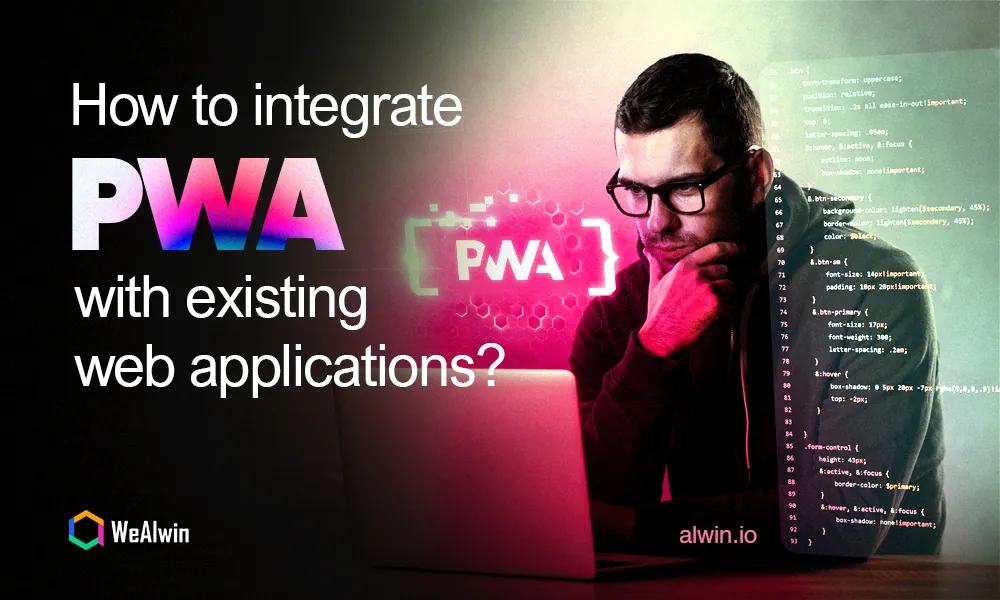Our Products
Our Services
Our Company
Newsletter
© 2024 WeAlwin Technologies Pvt Ltd.All Rights Reserved

Progressive Web Applications (PWAs) have emerged as a powerful solution, combining the best of web and mobile app functionalities to deliver a smooth and engaging user experience.
But what if you already have an existing web application?
Can you integrate PWA features into it seamlessly?
The answer is yes, and in this blog post, we'll explore how to do just that.
Before diving into the integration process, let's briefly review what PWAs are and why they're gaining traction in the tech world.
PWAs are web applications that leverage modern web capabilities to provide users with an app-like experience. They are fast, reliable, and engaging, offering features such as offline access, push notifications, and installation on the home screen. By harnessing service workers, PWAs can cache content and deliver a consistent experience even in low or no network conditions.
Integrating PWA features into your existing web application can offer numerous benefits, including:
Enhanced User Experience: PWAs provide a seamless experience across devices and platforms, improving user satisfaction and retention.
Improved Performance: By leveraging service workers and caching mechanisms, PWAs load faster and perform better, even on slower networks.
Increased Engagement: Features like push notifications and offline access keep users engaged and encourage return visits to your application.
Wider Reach: PWAs can be easily shared via URL, eliminating the need for app store downloads and expanding your audience reach.
1. Rapid Loading: PWAs utilize service workers to pre-cache content, resulting in exceptionally fast loading times and seamless navigation.
2. Offline Access: Service workers enable offline functionality, allowing users to access certain features and content even without an internet connection.
3. Push Notifications: Similar to native apps, PWAs can send personalized push notifications to keep users engaged and informed.
4. Home Screen Installation: Users can easily install PWAs on their home screen, creating shortcuts for quick access akin to native apps.
5. Full-Screen Mode: PWAs often support full-screen mode, further blurring the distinction between them and native apps.
6. Accessibility: PWAs adhere to web standards, making them accessible to users with disabilities through features like screen readers and keyboard navigation.
7. Geolocation: PWAs can access a user's location, enabling features such as location-based services and content.
8. Payment APIs: Secure payment integrations are possible with PWAs, facilitating convenient in-app purchases and transactions.
9. Security: PWAs built with HTTPS ensure secure data transmission and user privacy.
Now, let's delve into the steps to integrate PWA features into your existing web application:
Start by evaluating your existing web application to determine its compatibility with PWA requirements. Ensure that your application meets the criteria for being served over HTTPS, has a responsive design, and is mobile-friendly.
Create a web app manifest file that defines metadata for your PWA, such as its name, icons, and theme colors. This file provides information to the browser about how to display your application when installed on a user's device.
Service workers are the backbone of PWAs, enabling features like offline access and push notifications. Integrate service workers into your web application to handle requests, cache content, and deliver a reliable offline experience.
Implement push notification functionality to keep users engaged and informed about updates or relevant content. Use the Push API and service workers to deliver timely notifications to users, even when they're not actively using your application.
Optimize your PWA for performance by minimizing resource usage, leveraging browser caching, and optimizing images and assets. Aim for fast load times and smooth transitions to deliver a superior user experience.
Thoroughly test your integrated PWA across different devices and browsers to ensure compatibility and functionality. Gather feedback from users and iterate on your implementation to address any issues or optimize performance further.
Finally,
Integrating PWA features into your existing web application is a strategic move to enhance user experience, improve performance, and drive engagement. By following the steps outlined in this guide, you can seamlessly integrate PWAs into your web application and stay ahead in the competitive digital landscape. Embrace the power of PWAs development with WeAlwin and utilize new possibilities for your business today!